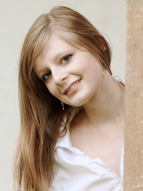
Visiting Ph.D.
molecular visualization
- katarina.furmanova@gmail.com
- HiB, room 309M1
Supervised by: Jan Byška
Publications
2018
[Bibtex]
@ARTICLE {Jurcik2018Caver,
author = "Adam Jur\v{c}\'{i}k and David Bedn\'{a}\v{r} and Jan By\v{s}ka and Sergio M. Marques and Katar\'{i}na Furmanov\'{a} and Luk\'{a}\v{s} Daniel and Piia Kokkonen and Jan Brezovsk\'{y} and Ond\v{r}ej Strnad and Jan \v{s}\v{t}oura\v{c} and Anton\'{i}n Pavelka and Martin Ma\v{n}\'{a}k and Ji\v{r}\'{i} Damborsk\'{y} and Barbora Kozl\'{i}kov\'{a}",
title = "CAVER Analyst 2.0: analysis and visualization of channels and tunnels in protein structures and molecular dynamics trajectories",
journal = "Bioinformatics",
year = "2018",
abstract = "MOTIVATION:Studying the transport paths of ligands, solvents, or ions in transmembrane proteins and proteins with buried binding sites is fundamental to the understanding of their biological function. A detailed analysis of the structural features influencing the transport paths is also important for engineering proteins for biomedical and biotechnological applications.RESULTS:CAVER Analyst 2.0 is a software tool for quantitative analysis and real-time visualization of tunnels and channels in static and dynamic structures. This version provides the users with many new functions, including advanced techniques for intuitive visual inspection of the spatiotemporal behavior of tunnels and channels. Novel integrated algorithms allow efficient analysis and data reduction in large protein structures and molecular dynamics simulations.",
images = "images/analyst.jpg",
thumbnails = "images/analyst.jpg"
} [Bibtex]
@ARTICLE {Furmanova2018COZOID,
author = "Furmanov{\'a}, Katar{\'\i}na and By{\v{s}}ka, Jan and Gr{\"o}ller, Eduard M and Viola, Ivan and Pale{\v{c}}ek, Jan J and Kozl{\'i}kov{\'a}, Barbora",
title = "COZOID: contact zone identifier for visual analysis of protein-protein interactions",
journal = "BMC bioinformatics",
year = "2018",
abstract = "BackgroundStudying the patterns of protein-protein interactions (PPIs) is fundamental for understanding the structure and function of protein complexes. The exploration of the vast space of possible mutual configurations of interacting proteins and their contact zones is very time consuming and requires the proteomic expert knowledge.ResultsIn this paper, we propose a novel tool containing a set of visual abstraction techniques for the guided exploration of PPI configuration space. It helps proteomic experts to select the most relevant configurations and explore their contact zones at different levels of detail. The system integrates a set of methods that follow and support the workflow of proteomics experts. The first visual abstraction method, the Matrix view, is based on customized interactive heat maps and provides the users with an overview of all possible residue-residue contacts in all PPI configurations and their interactive filtering. In this step, the user can traverse all input PPI configurations and obtain an overview of their interacting amino acids. Then, the models containing a particular pair of interacting amino acids can be selectively picked and traversed. Detailed information on the individual amino acids in the contact zones and their properties is presented in the Contact-Zone list-view. The list-view provides a comparative tool to rank the best models based on the similarity of their contacts to the template-structure contacts. All these techniques are interactively linked with other proposed methods, the Exploded view and the Open-Book view, which represent individual configurations in three-dimensional space. These representations solve the high overlap problem associated with many configurations. Using these views, the structural alignment of the best models can also be visually confirmed.ConclusionsWe developed a system for the exploration of large sets of protein-protein complexes in a fast and intuitive way. The usefulness of our system has been tested and verified on several docking structures covering the three major types of PPIs, including coiled-coil, pocket-string, and surface-surface interactions. Our case studies prove that our tool helps to analyse and filter protein-protein complexes in a fraction of the time compared to using previously available techniques.",
images = "images/cozoid.jpg",
thumbnails = "images/cozoid.jpg"
}2017
![[PDF]](http://vis.test.uib.no/wp-content/plugins/papercite/img/pdf.png) [Bibtex]
[Bibtex] @ARTICLE {Furmanova2017Ligand,
author = "Furmanov{\'a}, Katar{\'\i}na and Jare{\v{s}}ov{\'a}, Miroslava and By{\v{s}}ka, Jan and Jur{\v{c}}{\'i}k, Adam and Parulek, J{\'u}lius and Hauser, Helwig and Kozl{\'i}kov{\'a}, Barbora",
title = "Interactive exploration of ligand transportation through protein tunnels",
journal = "BMC Bioinformatics",
year = "2017",
volume = "18(Suppl 2)",
number = "22",
month = "feb",
abstract = "Background: Protein structures and their interaction with ligands have been in the focus of biochemistry andstructural biology research for decades. The transportation of ligand into the protein active site is often complexprocess, driven by geometric and physico-chemical properties, which renders the ligand path full of jitter andimpasses. This prevents understanding of the ligand transportation and reasoning behind its behavior along the path.Results: To address the needs of the domain experts we design an explorative visualization solution based on amulti-scale simplification model. It helps to navigate the user to the most interesting parts of the ligand trajectory byexploring different attributes of the ligand and its movement, such as its distance to the active site, changes of aminoacids lining the ligand, or ligand ââ¬Åstucknessââ¬?. The process is supported by three linked views ââ¬â 3D representation of thesimplified trajectory, scatterplot matrix, and bar charts with line representation of ligand-lining amino acids.Conclusions: The usage of our tool is demonstrated on molecular dynamics simulations provided by the domainexperts. The tool was tested by the domain experts from protein engineering and the results confirm that it helps tonavigate the user to the most interesting parts of the ligand trajectory and to understand the ligand behavior",
pdf = "pdfs/Furmanova2017.pdf",
images = "images/Furmanova2016Interactive.png",
thumbnails = "images/Furmanova2016Interactive.png",
note = "https://doi.org/10.1186/s12859-016-1448-0"
}